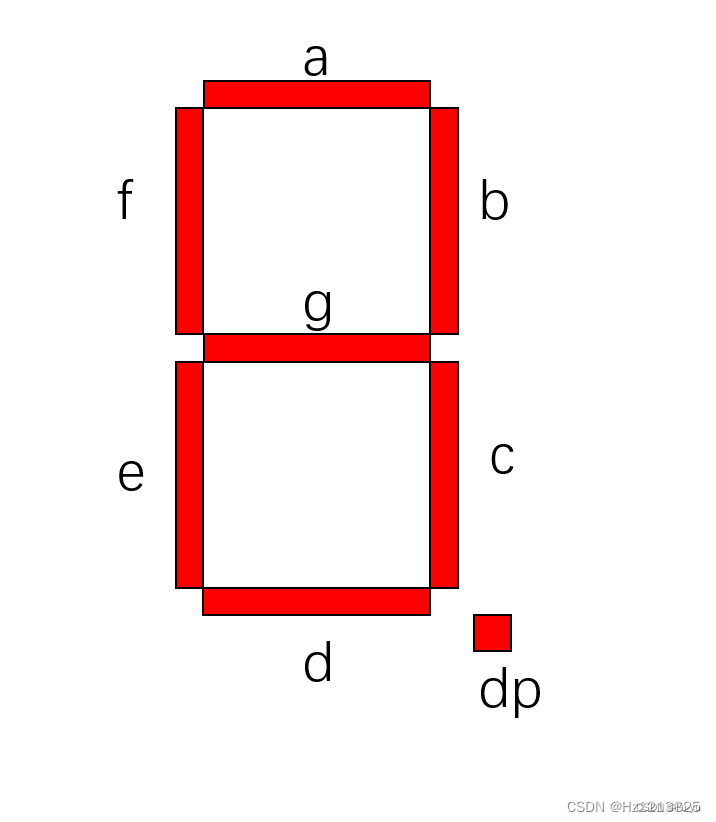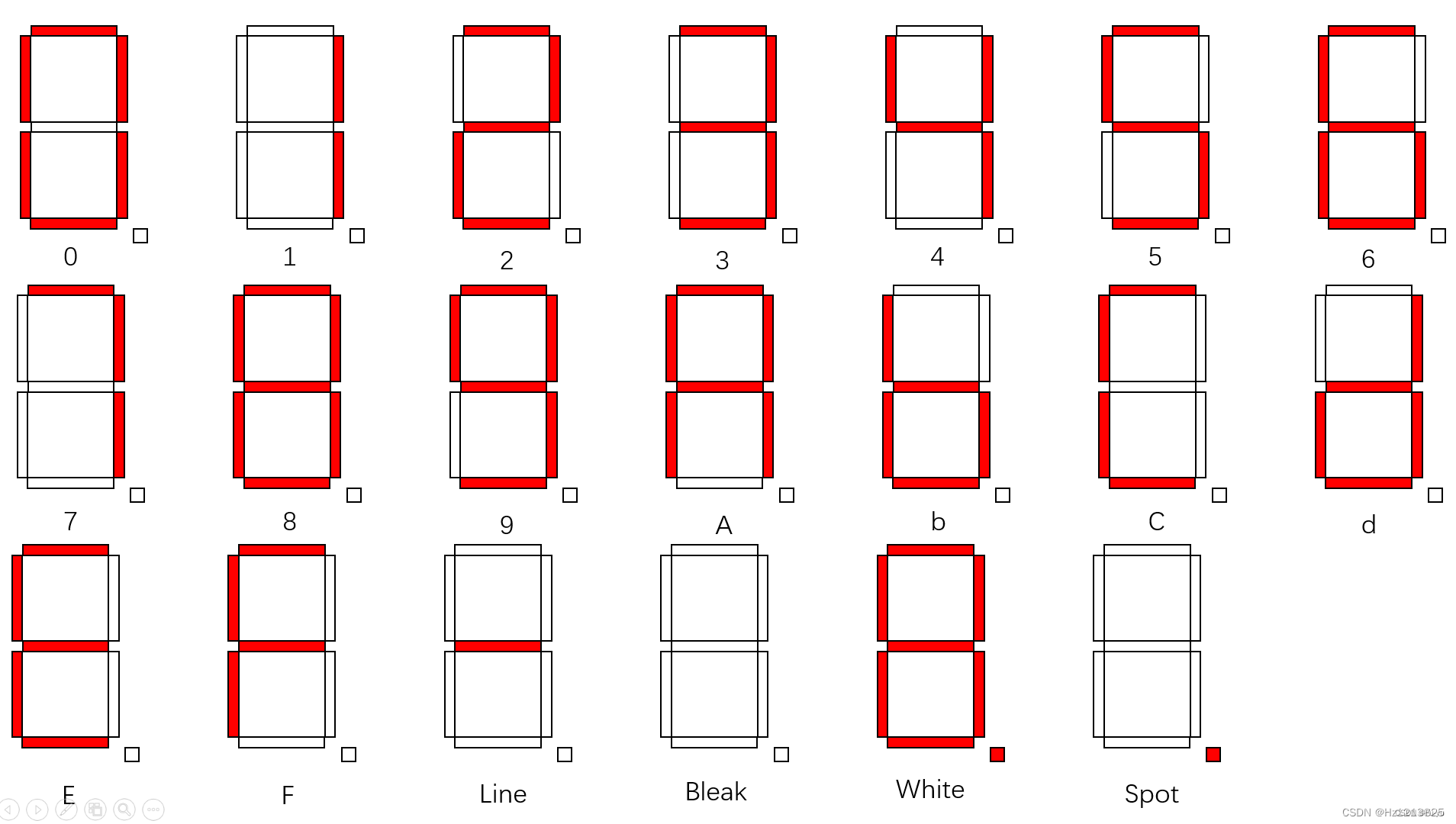Learning chip: EP4CE6F17C8
This study uses a common cathode digital tube, that is, the digital tube is lit with a low level. It is also known that the anodes of the common anode digital tube are connected together, that is, the digital tube is lit with a high level.
Schematic diagram of eight-segment digital tube:


When a,b,c,d,e,f,g,dg represent an eight-segment digital tube, a is the lowest bit, and dp is the highest bit
The eight-segment digital tube is represented by 8-bit binary. Since this experiment uses a common cathode digital tube, 0 means on, and 1 means off. That is, the digital tube displays the number 0, which we can use to represent, and the number F to represent. In the same way, the common cathode digital tube and the common anode digital tube are the opposite of each 8'b1100_0000other 8'b1000_0111.
1. Verilog programming enables six digital tubes to display 0-f at the same time, with a time interval of 0.5s
code show as below:
module seg_dynamic(
input wire clk,
input wire rst_n,
output wire [7:0] seg,//选择哪一段亮
output wire [5:0] sel//选择哪一个数码管亮
);
localparam CNT_0_5S_MAX = 25'd25_000_000;//0.5s
localparam CNT_20NS_MAX = 16'd50_000;//20ns
parameter ZERO = 8'b1100_0000,
ONE = 8'b1111_1001,
TWO = 8'b1010_0100,
THREE = 8'b1011_0000,
FOUR = 8'b1001_1001,
FIVE = 8'b1001_0010,
SIX = 8'b1000_0010,
SEVEN = 8'b1111_1000,
EIGHT = 8'b1000_0000,
NINE = 8'b1001_0000,
A = 8'b1000_1000,
B = 8'b1000_0011,
C = 8'b1100_0110,
D = 8'b1010_0001,
E = 8'b1000_0110,
F = 8'b1000_1110;
reg [24:0] cnt_0_5s;
reg [3:0] cnt_num;
reg [19:0] cnt_delay;
reg [2:0] cnt_seg;
reg [7:0] seg_r;
reg [5:0] sel_r;
//0.5s计数
always @(posedge clk or negedge rst_n) begin
if(!rst_n) begin
cnt_0_5s <= 25'd0;
end
else if(cnt_0_5s == CNT_0_5S_MAX-1'd1)begin
cnt_0_5s <= 25'd0;
end
else begin
cnt_0_5s <= cnt_0_5s +1'd1;
end
end
//20ms计数
always @(posedge clk or negedge rst_n) begin
if(!rst_n)begin
cnt_delay <= 16'd0;
end
else if(cnt_delay == CNT_20NS_MAX -1'd1)begin
cnt_delay <= 16'd0;
end
else begin
cnt_delay <= cnt_delay +1'd1;
end
end
always @(posedge clk or negedge rst_n) begin
if(!rst_n)begin
cnt_num <= 4'd0;
end
else if(cnt_num == 4'd15 && cnt_0_5s == CNT_0_5S_MAX-1'd1)begin
cnt_num <= 4'd0;
end
else if(cnt_0_5s == CNT_0_5S_MAX-1'd1)begin
cnt_num <= cnt_num +1'd1;
end
else begin
cnt_num <= cnt_num;
end
end
always @(posedge clk or negedge rst_n) begin
if(!rst_n)begin
cnt_seg <=3'd0;
end
else if(cnt_seg == 3'd5 && cnt_delay == CNT_20NS_MAX -1'd1)begin
cnt_seg <= 3'd0;
end
else if (cnt_delay == CNT_20NS_MAX -1'd1)begin
cnt_seg <= cnt_seg + 1'd1;
end
else begin
cnt_seg <=cnt_seg;
end
end
always @(posedge clk or negedge rst_n) begin
if(!rst_n)begin
sel_r <= 6'b111_110;
end
else if(cnt_seg == 3'd0 && cnt_delay == CNT_20NS_MAX -1'd1)begin
sel_r <= 6'b111_101;
end
else if(cnt_seg == 3'd1 && cnt_delay == CNT_20NS_MAX -1'd1)begin
sel_r <= 6'b111_011;
end
else if(cnt_seg == 3'd2 && cnt_delay == CNT_20NS_MAX -1'd1)begin
sel_r <= 6'b110_111;
end
else if(cnt_seg == 3'd3 && cnt_delay == CNT_20NS_MAX -1'd1)begin
sel_r <= 6'b101_111;
end
else if(cnt_seg == 3'd4 && cnt_delay == CNT_20NS_MAX -1'd1)begin
sel_r <= 6'b011_111;
end
else if(cnt_seg == 3'd5 && cnt_delay == CNT_20NS_MAX -1'd1)begin
sel_r <= 6'b111_110;
end
else begin
sel_r <= sel_r;
end
end
always @(posedge clk or negedge rst_n) begin
if(!rst_n)begin
seg_r <= 8'b1111_1111;
end
else begin
case (cnt_num)
4'd0: seg_r <= ZERO;
4'd1: seg_r <= ONE;
4'd2: seg_r <= TWO;
4'd3: seg_r <= THREE;
4'd4: seg_r <= FOUR;
4'd5: seg_r <= FIVE;
4'd6: seg_r <= SIX;
4'd7: seg_r <= SEVEN;
4'd8: seg_r <= EIGHT;
4'd9: seg_r <= NINE;
4'd10: seg_r <= A;
4'd11: seg_r <= B;
4'd12: seg_r <= C;
4'd13: seg_r <= D;
4'd14: seg_r <= E;
4'd15: seg_r <= F;
default: seg_r <= seg_r;
endcase
end
end
assign seg = seg_r;
assign sel = sel_r;
endmodule
Running result graph:

2. Verilog programming six digital tubes display 0-f in turn, the interval time is 0.5s
code show as below:
module seg_dynamic1(
input wire clk,
input wire rst_n,
output wire[7:0] seg,//选择哪一段亮
output wire[5:0] sel//选择哪一个亮
);
parameter MAX_0_5S = 25'd25_000_000;//0.5s
localparam CNT_20NS_MAX = 16'd50_000;//20ns
reg [7:0] seg_r;
reg [5:0] sel_r;
reg [24:0] cnt_0_5s;
reg [15:0] cnt_delay;
reg [3:0] cnt_num;
parameter ZERO = 8'b1100_0000,
ONE = 8'b1111_1001,
TWO = 8'b1010_0100,
THREE = 8'b1011_0000,
FOUR = 8'b1001_1001,
FIVE = 8'b1001_0010,
SIX = 8'b1000_0010,
SEVEN = 8'b1111_1000,
EIGHT = 8'b1000_0000,
NINE = 8'b1001_0000,
A = 8'b1000_1000,
B = 8'b1000_0011,
C = 8'b1100_0110,
D = 8'b1010_0001,
E = 8'b1000_0110,
F = 8'b1000_1110;
//0.5s倒计时
always @(posedge clk or negedge rst_n) begin
if(!rst_n)begin
cnt_0_5s <= 25'd0;
end
else if(cnt_0_5s == MAX_0_5S -1'd1) begin
cnt_0_5s <= 25'd0;
end
else begin
cnt_0_5s <= cnt_0_5s +1'd1;
end
end
//20ns倒计时
always @(posedge clk or negedge rst_n) begin
if(!rst_n)begin
cnt_delay <= 16'd0;
end
else if(cnt_delay == CNT_20NS_MAX -1'd1)begin
cnt_delay <= 16'd0;
end
else begin
cnt_delay <= cnt_delay +1'd1;
end
end
always @(posedge clk or negedge rst_n) begin
if(!rst_n)begin
cnt_num <= 4'd0;
end
else if(cnt_num == 4'd15 && cnt_0_5s == MAX_0_5S -1'd1)begin
cnt_num <= 4'd0;
end
else if( cnt_0_5s == MAX_0_5S -1'd1)begin
cnt_num <= cnt_num + 1'd1;
end
else begin
cnt_num <= cnt_num;
end
end
always @(posedge clk or negedge rst_n) begin
if(!rst_n) begin
sel_r <= 6'b111110;
end
else if(cnt_0_5s == MAX_0_5S -1'd1)begin
sel_r <= {sel_r[4:0],sel_r[5]};
end
else begin
sel_r <=sel_r;
end
end
always @(posedge clk or negedge rst_n) begin
if(!rst_n)begin
seg_r <= 8'b1111_1111;
end
else begin
case (cnt_num)
4'd0: seg_r <= ZERO;
4'd1: seg_r <= ONE;
4'd2: seg_r <= TWO;
4'd3: seg_r <= THREE;
4'd4: seg_r <= FOUR;
4'd5: seg_r <= FIVE;
4'd6: seg_r <= SIX;
4'd7: seg_r <= SEVEN;
4'd8: seg_r <= EIGHT;
4'd9: seg_r <= NINE;
4'd10: seg_r <= A;
4'd11: seg_r <= B;
4'd12: seg_r <= C;
4'd13: seg_r <= D;
4'd14: seg_r <= E;
4'd15: seg_r <= F;
default: seg_r <= seg_r;
endcase
end
end
assign seg = seg_r;
assign sel = sel_r;
endmodule
The running result graph is as follows:
